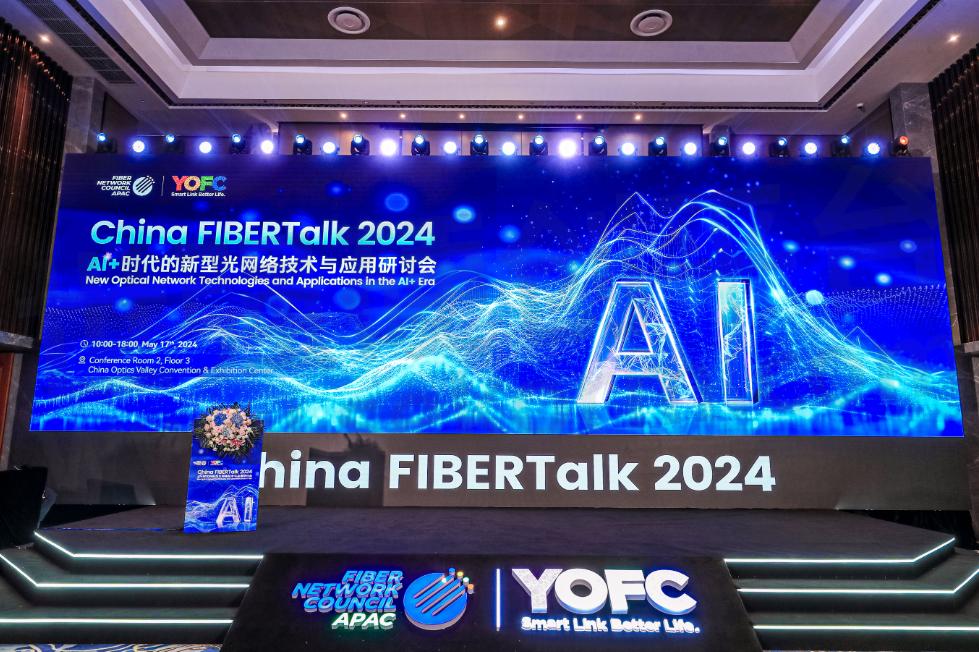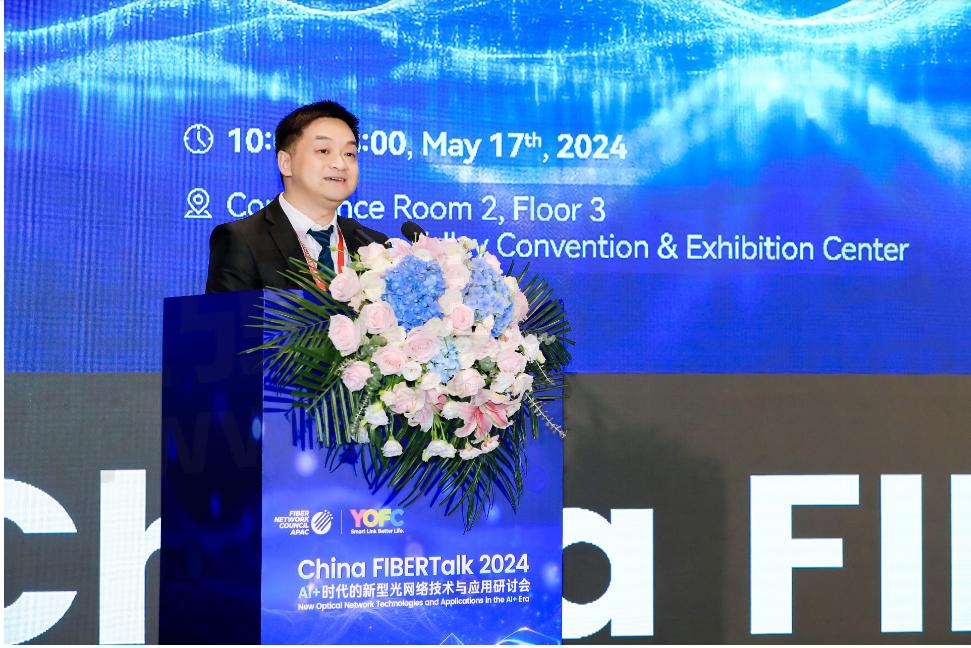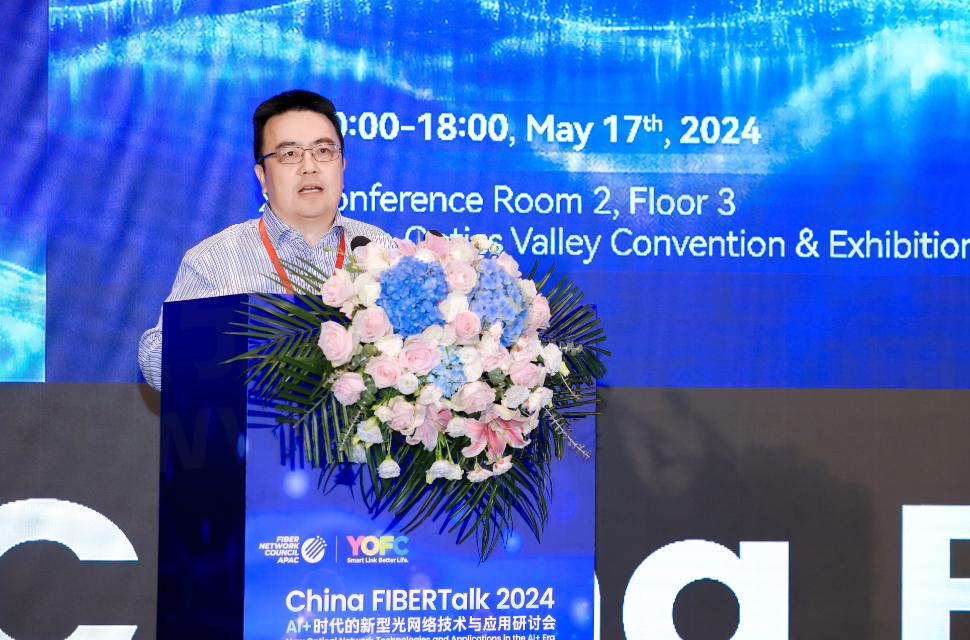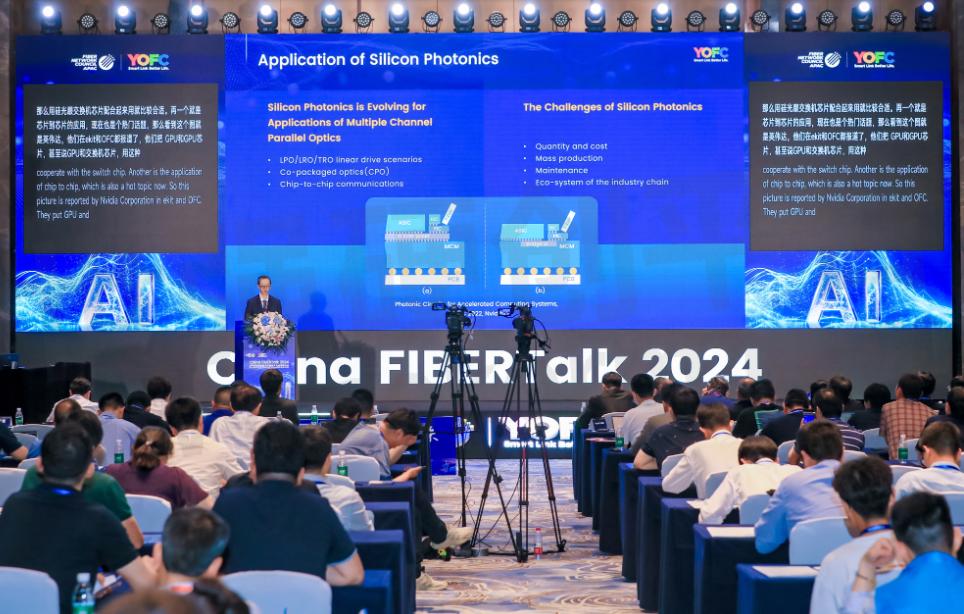AI Drives the Revolution of Optical Network Technology: China FIBERTalk 2024 Held at Optics Valley of China

On May 17, the China FIBERTalk 2024 took place at Optics Valley, Wuhan, China. Co-sponsored by the Fiber Network Council APAC (FNCA) and Yangtze optical fibre and Cable Joint Stock Limited Company (YOFC, stock code: 601869.SH, 06869.HK), the event gathered leaders and experts from globally well-known telecom and mobile network operators, network service providers, research institutes, and enterprises to delve into new optical fibre network technologies and applications in the AI+ era.

Fig.1
Xiong Zhuang, President of FNCA and Chief Scientist of YOFC, delivered a speech at the conference. Xiong stated that this is the second time FNCA has partnered with YOFC to host an industry exchange meeting in Optics Valley of China, following the FTTH APAC Conference 2019. FNCA is committed to promoting the widespread adoption of fibre networks. In the AI+ era, the integration of AI and fibre networks has ushered in numerous possibilities, enhancing efficiency and reliability while facilitating the emergence of new services and applications. The synergy between AI and fibre networks is driving a fresh wave of technological progress. As an industry association, FNCA will continue to give full play to its role as a bridge, establishing more platforms for industry exchanges and collaborations, and striving to promote the widespread adoption and advancement of optical fibre network technologies, thereby shaping a new future of connectivity in the Asia-Pacific region.

Fig.2
Zhuang Dan, Executive Director and President of YOFC, delivered a welcoming speech, extending a warm welcome to the attendees of the conference and expressing deep gratitude to FNCA for its trust and support. Zhuang mentioned that driven by AI, optical fibre network technology is ushering in new development opportunities. He emphasized that the relationship between AI and optical fibre networks is mutually beneficial, each propelling advancements in the other. As AI applications become more sophisticated and data intensive, the need for robust optical fibre infrastructure continues to grow. In turn, high-quality optical fibre networks leveraging new optical fibre technology empower AI systems to process and analyze data at unprecedented rates. This unlocks new possibilities for innovation across various sectors. Zhuang expressed his hope that this conference could catalyze innovation, promoting new advancements in optical fibre network technology.

Fig.3
Focusing on the conference theme, "New Optical Network Technologies and Applications in the AI+ Era", well-known experts in the field of optical communication from the three major operators engaged in profound discussions regarding new optical networks based on network deployment requirements. Ao Li, Chief Engineer of China Academy of Information and Communications Technology (CAICT), highlighted that the AI+ era drives the continuous evolution of optical communication towards high speed, large capacity, all-optical networking, and intelligence. As a result, it becomes imperative to strengthen collaborative and efficient support for high-speed transmission, modular devices, optical fibres and cables, intelligent control, and transport capacity evaluation systems.
Zhang Chengliang, President of China Telecom Research Institute, mentioned that China Telecom is currently engaged in technological innovations such as intelligent middleware, open connection protocol, and integrating AI computing power, delivering standardized products and solutions with "network + service + capability" as the core for FTTR development. Wang Guangquan, Chief Engineer of China Unicom Research Institute, introduced the digital transformation solution specifically tailored to the characteristics and intelligent operation and maintenance requirements of new-generation optical networks. This solution incorporates digital twin technology into optical networks, enabling dynamic modeling and intelligent optimization of optical networks using big data analysis, photoelectric mathematical models, and deep learning algorithms. Gao Junshi, Director of the Division of Optical Communication of China Mobile Group Design Institute, emphasized the necessity for optical transmission networks to address the requirements for higher bandwidth, stability, and reliability in the context of centralized network functions. He also highlighted the need for these networks to incorporate more intelligent network operation capabilities and remote maintenance capabilities.
As a global leader in optical communication, YOFC showcased its new optical fibre and optical transceiver products. These products are specifically tailored to the needs of high-speed, efficient, and intelligent communication networks amidst the surge of AI technology. Raadjkoemar Matai, Chief Scientist of Optical Fibre at YOFC, delivered a speech under the theme of "YOFC Advanced Fibre Innovation & Application". Focusing on the optical fibre industry development and associated challenges, Matai highlighted the research and development activities, industrialization progress, and industry applications of YOFC's next-generation fibre products such as G.654.E fibre, multi-core fibre, few-mode fibre, and hollow-core fibre. Chu Yuanliang, Chief Scientist of Optical Transceiver at YOFC, introduced the company's client-side optical interconnect technology with higher speed and complexity. This technology is applied on the server and user sides of AI based on AIGC's large model applications. Additionally, Chu introduced YOFC's optical transceiver and other advanced optical interconnect products.

Fig.4
Wu Guangzhe, Deputy Director of the Communication Engineering Center of State Grid Information & Telecommunication Branch, introduced the research and application of multi-dimensional perception fusion technology for the power optical cable network. Melanie Germentil, Chief Procurement & Logistics Officer of InfiniVAN, a network service provider in the Philippines, discussed the submarine cable network project in the country. NISHIGUCHI Yuki, General Manager of Senko HK/China, delivered a keynote speech titled "Responsible AI Advancement, Balancing Growth with Sustainability". Representatives from Huawei, China Telecommunication Technology Labs, and ZTE expressed their expert insights on key technologies, research findings, and practical applications of optical networks.
Originating from the invention of optical fibre, optical networks have evolved alongside advancements in information and communication technology, ushering in greater opportunities in the AI digital era. It is believed that through joint efforts across the global industry, optical network technology will better empower the development and application of AI technology, ultimately fostering social prosperity!
- +1 Like
- Add to Favorites
Recommend
- YOFC Assists Three Major Operators in Advancing the Industrialization of Hollow-core Optical Fibres, Setting Multiple World Records in Optical Transmission
- II-VI Incorporated Introduces Optical Monitoring System for Optical Transport and Access Networks
- PLC Optical Splitter vs FBT Optical Splitter: What‘s the Difference?
- The Difference Between 100G QSFP28 Fiber Optical Transceiver and 100G CFP4 Fiber Optical Transceiver
- Comparison between AOC (Active Optical Cables) and Optical Transceivers
- II-VI to Double Manufacturing Capacity of Optical Filters for PCR Instrumentation and 5G Optical Access Over a 5-Year Investment
- Reflex Photonics‘s 28 Gbps per Lane Rugged Embedded Optical Modules and Radiation-resistant Optical Modules
- New Year Message from YOFC: Salute to Dedication in 2023 and Keep Going in 2024
This document is provided by Sekorm Platform for VIP exclusive service. The copyright is owned by Sekorm. Without authorization, any medias, websites or individual are not allowed to reprint. When authorizing the reprint, the link of www.sekorm.com must be indicated.






























































































































































































































































































































































































































































































































































































































































































































































































































































































